- »Classes
- »Workshops/
Special Events - »Calendar
- »Gallery
- »Links
- »About Belly Dance
- The History and Mystery of Bellydance
- Dance in Egypt as a Celebration of Daily Life
- Ghawazee: The Dancing Girls of Egypt
- Current Egyptian movements: what's old is new again!
Habiba will show you how to take the movements currently favored in Egypt and incorporate them into your dance routine. - Egyptian Nightclub Style Choreography with Drum Solo.
- Beledi Call and Response:
Practically every cabaret routine has a section that is called beledi call and response. It is at the heart of the Egytpian style nightclub performance. It is one of the most intense moments in the routine, providing the bridge between the taqsim and the drum solo. It includes improvisational and traditional elements. Not only is it one of the oldest components of belly dance but it is a great opportunity to show off your newest Egyptian isolations. - Ghawazee
The ghawazee were the famous public dancing girls of Egypt. They carried on the gypsy tradition of entertaining as a hereditary occupation. This earthy dance style forms a major part of the heritage of the oriental dancer. - Nubian: Style of the Nubian people on the Egypt/Sudan border.
- Bedouin: Hagallah style, the dance of the Western Desert Bedouins.
- Fellahin and Saidi: Dance styles of the Egyptian peasant.
- Pot Dance (Raks al Juzur):
The Pot Dance comes from the south of Tunisia, the islands of Djerba and Kerkennah. Djerba is reputed to be the island known as "The Land of the Lotus Eaters" in the Odyssey. The dance clebrates the main industry of the area, pottery. Both men and women perform this feat of balance at weddings. The dancer executes twisting movements to increasingly faster music while balancing a water jug on her head. It is also one of the signature dances of the national troupe. - Scarf Dance (Raks al Maharem):
Originally a flirtatious cafe dance, it took on a more patriotic meaning when dancers started to use a red and a white scarf to support the independence movement in the 1950's. After independence this became the signature dance of the Tunisian National Troupe.

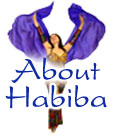


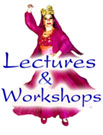

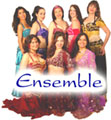

Habiba
The Studio
Habiba Dance Ensemble
Lectures and Workshops
Habiba offers lectures based on her years of research on the history of dance in the Middle East, and workshops that teach movements and choreographies learned directly from the source.
Children's versions of these interesting lectures and demonstrations are also available.

Lectures:
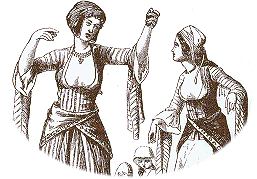
Reviews of Habiba's Workshops and Lectures
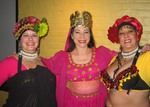 Read a review from Associated Content on Habiba's
Read a review from Associated Content on Habiba's
workshops on Ghawazee and Andalusian dance.
Read a review of Habiba's Ghawazee workshop by Miriam, director of Anka Kusu
Workshops:
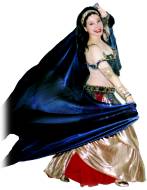
Raqs Sharqi

Egyptian Folklore:
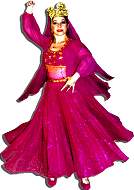
Andalusian Dance:
The dancers known as "jariya" were slave girls who performed in the noble houses of Andalusian Spain and throughout the Arab world. Based on the classical music and dance that originated in Andalusian Spain and traveled to North Africa when the Arabs were expelled. The dance emphasizes the elegant arm and hand movements of the court dancer.
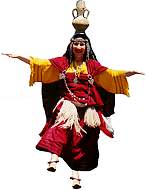
Tunisian Dance:
Tunisia, the easternmost country in North Africa has a richly mixed cultural heritage that includes Phoenician, Berber, Roman, early Christian, Islamic and Jewish elements. The folkloric Tunisian style is earthy, concentrated in sharp twisting movements of the hips.
Contact Habiba for more information on booking a lecture or workshop. She can design an exciting program to fit your needs.
Template design by Six Shooter Media.
This website and all photographs within, are
©2010 Barbara Siegel, and may not
be used without her permission.
Website maintained by Fatima Bassmah








Habiba
The Studio
Habiba Dance Ensemble
Lectures and Workshops
Lectures:
|
|

|
Reviews of Habiba's Workshops and Lectures
 Read a review from Associated Content on Habiba's
Read a review from Associated Content on Habiba's workshops on Ghawazee and Andalusian dance. |
| Read a review of Habiba's Ghawazee workshop by Miriam, director of Anka Kusu |
Workshops:

|
Raqs Sharqi
|

|
Egyptian Folklore:
|

|
Andalusian Dance:
The dancers known as "jariya" were slave girls who performed in the noble houses of Andalusian Spain and throughout the Arab world. Based on the classical music and dance that originated in Andalusian Spain and traveled to North Africa when the Arabs were expelled. The dance emphasizes the elegant arm and hand movements of the court dancer. |

|
Tunisian Dance:
Tunisia, the easternmost country in North Africa has a richly mixed cultural heritage that includes Phoenician, Berber, Roman, early Christian, Islamic and Jewish elements. The folkloric Tunisian style is earthy, concentrated in sharp twisting movements of the hips. |
Template design by Six Shooter Media.
This website and all photographs within, are
©2010 Barbara Siegel, and may not
be used without her permission.
Website maintained by Fatima Bassmah
